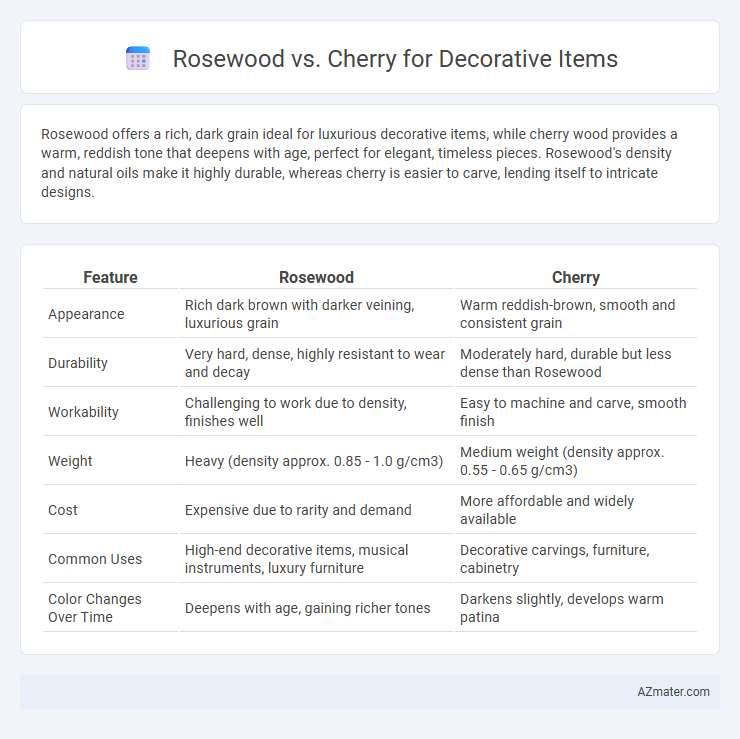Rosewood offers a rich, dark grain ideal for luxurious decorative items, while cherry wood provides a warm, reddish tone that deepens with age, perfect for elegant, timeless pieces. Rosewood's density and natural oils make it highly durable, whereas cherry is easier to carve, lending itself to intricate designs.
Table of Comparison
| Feature | Rosewood | Cherry |
|---|---|---|
| Appearance | Rich dark brown with darker veining, luxurious grain | Warm reddish-brown, smooth and consistent grain |
| Durability | Very hard, dense, highly resistant to wear and decay | Moderately hard, durable but less dense than Rosewood |
| Workability | Challenging to work due to density, finishes well | Easy to machine and carve, smooth finish |
| Weight | Heavy (density approx. 0.85 - 1.0 g/cm3) | Medium weight (density approx. 0.55 - 0.65 g/cm3) |
| Cost | Expensive due to rarity and demand | More affordable and widely available |
| Common Uses | High-end decorative items, musical instruments, luxury furniture | Decorative carvings, furniture, cabinetry |
| Color Changes Over Time | Deepens with age, gaining richer tones | Darkens slightly, develops warm patina |
Introduction to Rosewood and Cherry
Rosewood is a dense, dark hardwood known for its rich aroma and striking grain patterns, often used in high-end decorative items for its durability and luxurious appearance. Cherry wood features a warm reddish-brown hue that deepens with age, prized for its smooth texture and fine grain, making it a popular choice for elegant, classic decorative pieces. Both woods offer unique aesthetic qualities, with rosewood excelling in richness and hardness, while cherry stands out for its subtle warmth and refined finish.
Origin and Botanical Differences
Rosewood, primarily sourced from Dalbergia species native to tropical regions of Central and South America, Africa, and Asia, is prized for its dense, oily texture and strong natural fragrance, offering rich hues ranging from deep purples to reddish-browns. Cherry wood originates from the Prunus genus, predominantly found in North America and Europe, characterized by a fine, smooth grain and warm reddish-brown color that darkens with age. Botanically, Rosewood belongs to the Fabaceae family and features complex grain patterns and higher natural oils, whereas Cherry belongs to the Rosaceae family, exhibiting a more uniform texture with less inherent oil content, impacting both appearance and carving properties in decorative items.
Color and Grain Patterns
Rosewood features rich, deep reddish-brown hues with dark streaks, providing a bold and exotic aesthetic for decorative items. Cherry wood offers a warm, reddish-orange tone that darkens gracefully over time, showcasing a smooth, fine grain with subtle patterns. The contrasting grain patterns make rosewood ideal for statement pieces, while cherry suits classic and elegant decor styles.
Durability and Hardness Comparison
Rosewood exhibits superior durability with a Janka hardness rating averaging 2200, making it highly resistant to dents and scratches, ideal for long-lasting decorative items. Cherry wood, with a Janka hardness around 950, offers moderate hardness and ages gracefully, developing a rich patina over time. The dense grain and toughness of rosewood ensure greater resilience in high-impact environments, while cherry provides a softer, warmer aesthetic suitable for delicate decorations.
Workability and Craftsmanship
Rosewood offers superior workability for decorative items due to its dense grain and smooth finish, enabling craftsmen to achieve intricate detailing and fine carving with ease. Cherry wood, while slightly softer, excels in craftsmanship by providing a warm, rich tone and better flexibility for shaping, making it ideal for elegant curves and traditional designs. Both woods allow high-quality craftsmanship but differ in texture and hardness, impacting the level of detail possible in decorative projects.
Finish and Aging Characteristics
Rosewood offers a rich, dark finish with deep reddish-brown tones that develop a luxurious patina over time, enhancing its natural grain and luster. Cherry wood begins with a light pinkish-brown shade that gradually darkens to a warm, reddish-brown hue, providing a smooth, satiny finish that becomes more pronounced with age. Both woods improve aesthetically with exposure, but Rosewood's finish tends to retain a more glossy and vivid appearance, while Cherry's finish matures into a softer, elegant sheen.
Cost and Availability
Rosewood tends to be more expensive than cherry due to its rarity and limited availability, often priced significantly higher per board foot. Cherry wood is widely available and more affordable, making it a popular choice for decorative items and furniture with consistent supply from North American sources. The cost difference directly impacts the choice for decorative projects, with rosewood favored for luxury pieces and cherry preferred for budget-conscious designs.
Environmental Impact and Sustainability
Rosewood is often sourced from slow-growing tropical trees, leading to higher risks of deforestation and habitat loss, with many rosewood species listed under CITES regulations to prevent illegal logging. Cherry wood, derived from faster-growing temperate trees, is generally more sustainable due to its abundant availability and better forest management practices. Choosing cherry for decorative items typically results in a lower environmental impact and supports more sustainable forestry compared to rosewood.
Best Uses for Decorative Items
Rosewood excels in decorative items requiring rich, dark hues and intricate grain patterns, making it ideal for luxury furniture accents, inlays, and sculptures. Cherry wood offers a lighter, warm reddish tone that deepens over time, perfect for classic carved ornaments, picture frames, and small decorative boxes. Both woods provide durability and smooth finishes, but rosewood's exotic appearance suits high-end, statement pieces while cherry's versatility supports timeless, everyday decor.
Choosing Between Rosewood and Cherry
Rosewood offers a rich, dark hue with natural oils that provide durability and resistance to moisture, making it ideal for high-end decorative items requiring longevity and intricate grain patterns. Cherry wood features a warm reddish tone that deepens over time, offering a smooth texture favored for classic and elegant decorative pieces. Choosing between rosewood and cherry depends on the desired aesthetic, with rosewood suited for bold, exotic designs and cherry preferred for timeless, refined looks in decorative items.

Infographic: Rosewood vs Cherry for Decorative Item
 azmater.com
azmater.com